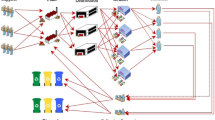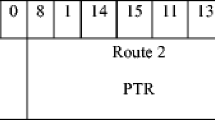Abstract
In a competitive online retail market, orders for assembled products such as refrigerators, air conditioners, smart televisions, etc., attract significant attention due to their high gross merchandise value. Unlike other regular products, product delivery has a two-stage process—delivery of product components and assembly and installation of the final product—involving multiple parties that may be internal or external to the organization. Coordination of the above activities is essential to reduce customer dissatisfaction and to curb the various waiting or demurrage costs due to delayed arrivals of goods vehicles and traveling salesman. This paper attempts to model and solve such a realistic synchronized goods delivery and service problem against the online booking. In this model, one goods vehicle starts from the company’s storehouse with all the goods to be delivered and moves continually, dropping the goods at the specified locations. For service, a traveling salesman separately moves and uses the appropriate conveyances among the available ones at each node to reach the customers. This paper poses some interesting research questions to understand the requirements of separate tour paths for goods vehicles and traveling salesman along with appropriate conveyance for traveling salesman’s arrival. This is an NP-hard traveling salesman problem. For solving, a varied offspring memetic algorithm (VOMA) with modified probabilistic selection, varied offspring three-parent (i.e., surro-embryos) crossover and Fibo-generation-dependent mutation is developed and tested on some standard test functions to establish its superiority over the standard ones. VOMA implementation on the above proposed problem reveals the influence of unloading and service times, halt time and third-party outsourcing charges on the final optimum route design. Finally, the paper provides a structured decision-making framework for practitioners and showcases a case study by implementing VOMA in a similar problem context.
















Similar content being viewed by others
Data availability
Data available on request.
References
Albayrak M, Allahverdi N (2011) Development a new mutation operator to solve the traveling salesman problem by aid of genetic algorithms. Expert Syst Appl 38(3):1313–1320
Averbakh I, Yu W (2018) Multi-depot traveling salesmen location problems on networks with special structure. Ann Oper Res 635–648
Bailay R (2018) Ikea bets on small stores to go digital. https://economictimes.indiatimes.com/industry/services/retail/ikea-bets-on-small-stores-to-go-digital/articleshow/66743638.cms?from=mdr
Baldwin JM (1896) A new factor in evolution. Am Nat 30(354):441–451
BBC (2018) Surrogate mother of ’twins’ finds one is hers. https://www.bbc.com/news/health-41858232
Beamurgia M, Basagoiti R, Rodríguez I, Rodríguez V (2022) Improving waiting time and energy consumption performance of a bi-objective genetic algorithm embedded in an elevator group control system through passenger flow estimation. Soft Comput 26(24):13673–13692
Carrabs F, Cerulli R, Sciomachen A (2017) An exact approach for the grocery delivery problem in urban areas. Soft Comput 21(9):2439–2450
Chang T-S, Wan Y-W, Ooi WT (2009) A stochastic dynamic traveling salesman problem with hard time windows. Eur J Oper Res 198(3):748–759
Constantinescu E (2012) Three dimensional mari time transportation models. https://www.scribd.com/document/419467025/Three-Dimensional-Maritime-Transportation-Models
Cordeau J-F, Laporte G, Potvin J-Y, Savelsbergh MW (2007) Transportation on demand. Handbk Oper Res Manag Sci 14:429–466
Corporation X (2012) Reliable installation service from MI. https://www.mi.com/in/service/tv_installationservice/
Derrac J, García S, Molina D, Herrera F (2011) A practical tutorial on the use of nonparametric statistical tests as a methodology for comparing evolutionary and swarm intelligence algorithms. Swarm Evol Comput 1(1):3–18
Dong G, Guo WW, Tickle K (2012) Solving the traveling salesman problem using cooperative genetic ant systems. Expert Syst Appl 39(5):5006–5011
Eiben AE, Raue PE, Ruttkay Z (1994) Genetic algorithms with multi-parent recombination. In: International conference on parallel problem solving from nature. Springer, pp 78–87
Feng Z (2019) Constructing rural e-commerce logistics model based on ant colony algorithm and artificial intelligence method. Soft Comput 23(15):6697–6714
Focacci F, Lodi A, Milano M (2002) A hybrid exact algorithm for the TSPTW. INFORMS J Comput 14(4):403–417
Forum WE (2018) Where people work the longest hours. https://www.weforum.org/agenda/2018/01/the-countries-where-people-work-the-longest-hours/
Ghoseiri K, Sarhadi H (2008) A memetic algorithm for symmetric traveling salesman problem. Int J Manag Sci Eng Manag 3(4):275–283
Haley K (1963) The multi-index problem. Oper Res 11(3):368–379
Haxhimusa Y, Carpenter E, Catrambone J, Foldes D, Stefanov E, Arns L, Pizlo Z (2011) 2d and 3d traveling salesman problem. J Problem Solv 3(2):8
Lagarteja JG, Gerardo BD, Medina RP (2017) Improved genetic algorithm using new crossover operator. In: Proceedings of 4th international conference on innovations in engineering, technology, computers and industrial applications (IETCIA-17) Aug, pp 3–4
Lawler E, Lenstra J, Rinnooy Kan A, Shmoys D (1985) The traveling salesman problem: Ge re guided tour of combinatorial optimization. Wiley and Sons, New York
Lee CW, Wong WP (2022) Last-mile drone delivery combinatorial double auction model using multi-objective evolutionary algorithms. Soft Comput 26:12355–12384
Ma Y, Li Z, Yan F, Feng C (2019) A hybrid priority-based genetic algorithm for simultaneous pickup and delivery problems in reverse logistics with time windows and multiple decision-makers. Soft Comput 23(15):6697–6714
Maity S, Roy A, Maiti M (2015) A modified genetic algorithm for solving uncertain constrained solid travelling salesman problems. Comput Ind Eng 83:273–296
Maity S, Roy A, Maiti M (2017) An intelligent hybrid algorithm for 4-dimensional tsp. J Ind Inf Integr 5:39–50
Majumdar J, Bhunia AK (2011) Genetic algorithm for asymmetric traveling salesman problem with imprecise travel times. J Comput Appl Math 235(9):3063–3078
Malaguti E, Martello S, Santini A (2018) The traveling salesman problem with pickups, deliveries, and draft limits. Omega 74:50–58
Martínez-Estudillo AC, Hervás-Martínez C, Martínez-Estudillo FJ, García-Pedrajas N (2005) Hybridization of evolutionary algorithms and local search by means of a clustering method. IEEE Trans Syst Man Cybern B (Cybern) 36(3):534–545
Merz P, Freisleben B (2001) Memetic algorithms for the traveling salesman problem. Complex Syst 13(4):297–346
Moon C, Kim J, Choi G, Seo Y (2002) An efficient genetic algorithm for the traveling salesman problem with precedence constraints. Eur J Oper Res 140(3):606–617
Moscato P et al (1989) On evolution, search, optimization, genetic algorithms and martial arts: towards memetic algorithms. Caltech concurrent computation program, C3P Report, 826:1989
Nagata Y, Soler D (2012) A new genetic algorithm for the asymmetric traveling salesman problem. Expert Syst Appl 39(10):8947–8953
Petersen HL, Madsen OB (2009) The double travelling salesman problem with multiple stacks-formulation and heuristic solution approaches. Eur J Oper Res 198(1):139–147
Reardon S (2017) Genetic details of controversial ‘three-parent baby’ revealed. Reprod Biol 544:17–18
Reinelt G (1995) Tsplib. http://www.iwr.uni-heidelberg.de/groups/comopt/software. TSPLIB95
Rodriguez-Roman D (2018) A surrogate-assisted genetic algorithm for the selection and design of highway safety and travel time improvement projects. Saf Sci 103:305–315
Roy A, Chakraborty G, Khan I, Maity S, Maiti M (2016) A hybrid heuristic for restricted 4-dimensional TSP (R-4DTSP). In: International conference on frontiers in optimization: theory and applications. Springer, pp 285–302
Sarkar R (2014) Ro leads, but kent thirsty for more
Skinner MK (2015) Environmental epigenetics and a unified theory of the molecular aspects of evolution: a neo-Lamarckian concept that facilitates neo-darwinian evolution. Genome Biol Evol 7(5):1296–1302
Tüű-Szabó B, Földesi P, Kóczy LT (2017) An efficient new memetic method for the traveling salesman problem with time windows. In: International workshop on multi-disciplinary trends in artificial intelligence. Springer, pp 426–436
Wang J, Ersoy OK, He M, Wang F (2016) Multi-offspring genetic algorithm and its application to the traveling salesman problem. Appl Soft Comput 43:415–423
Wang Y (2015) An approximate method to compute a sparse graph for traveling salesman problem. Expert Syst Appl 42(12):5150–5162
Wang Y, Li J, Pan Q, Sun J, Ren L (2010) Memetic algorithm based on improved inver-over operator for TSP. In: 2010 sixth international conference on natural computation (ICNC), vol 5. IEEE, pp 2386–2389
Wang Z, Lin W-H (2017) Incorporating travel time uncertainty into the design of service regions for delivery/pickup problems with time windows. Expert Syst Appl 72:207–220
Xu X, Yuan H, Matthew P, Ray J, Bagdasar O, Trovati M (2019) Gorts: genetic algorithm based on one-by-one revision of two sides for dynamic travelling salesman problems. Soft Comput 24:7197–7210
Ye T, Wang T, Lu Z, Hao JK (2014) A multi-parent memetic algorithm for the linear ordering problem. arXiv preprint arXiv:1405.4507
Funding
The authors have not disclosed any funding.
Author information
Authors and Affiliations
Corresponding author
Ethics declarations
Conflict of interest
The authors certify that there is no conflict of interest with any individual/organization for the present work.
Human participants
This paper does not contain any studies with human participants or animals performed by any of the authors.
Informed consent
Informed consent was obtained from all individual participants included in this study.
Additional information
Publisher's Note
Springer Nature remains neutral with regard to jurisdictional claims in published maps and institutional affiliations.
Appendix A Input data
Appendix A Input data
Here, we have taken the distance matrix, transportation cost and time per unit distance, traveling cost and time per unit distance, predefined demand/requirement, unload time and cost, servicing time and cost at every node and three types of traveling salesman vehicle and only one type of goods vehicle are considered. Also values of the parameters for STSPwGDS are presented in Tables 10, 11, 12, 13, 14, 15, 16, 17, 18, 19, 20, 21 and 22.
Rights and permissions
Springer Nature or its licensor (e.g. a society or other partner) holds exclusive rights to this article under a publishing agreement with the author(s) or other rightsholder(s); author self-archiving of the accepted manuscript version of this article is solely governed by the terms of such publishing agreement and applicable law.
About this article
Cite this article
Maji, S., Maity, S., Bsau, S. et al. Varied offspring memetic algorithm with three parents for a realistic synchronized goods delivery and service problem. Soft Comput 28, 4235–4265 (2024). https://doi.org/10.1007/s00500-023-09574-y
Accepted:
Published:
Issue Date:
DOI: https://doi.org/10.1007/s00500-023-09574-y




